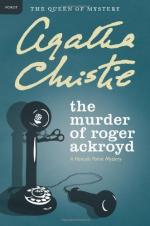|
This section contains 150 words (approx. 1 page at 400 words per page) |

|
The chief literary precedent for detective and crime fiction is Edgar Allan Poe's "The Murders in the Rue Morgue" (1841), and his other "tales of ratiocination," with their emphasis on logical deduction in solving a crime.
Closer to Christie is Arthur Conan Doyle and his Sherlock Holmes tales.
Conan Doyle introduced the eccentric amateur detective, his less sharp- witted chronicler (Poirot's Watson is Captain Hastings), the atmosphere of the English countryside and of London, the importance of careful observation, and the detective story as intellectual exercise. Indeed, since Conan Doyle, the detective story has been the favorite popular genre of intellectuals. During the so-called Golden Age of detective fiction — the 1920s and 1930s — when Christie came to popularity, other writers of the genre used the similar "classic" form, in particular Dorothy Sayers, and the tradition continues to the present in the books of Ruth Rendell...
|
This section contains 150 words (approx. 1 page at 400 words per page) |

|




